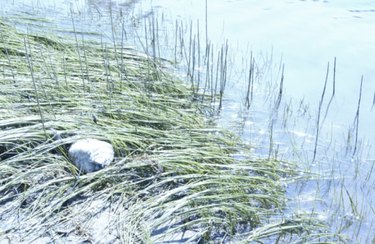
Lakes and aquatic plants naturally go together, but too many plants of the wrong kind create a weed problem. Although no one method controls or removes all lake weeds, you can reduce them with prevention, manual or chemical removal, or biological control. The best method depends on the type and extent of the weeds, water and environmental considerations, and cost.
Prevention
Video of the Day
If weeds and algae cover more than a quarter of your lake, the health of the water and your ability to enjoy it suffers. Preventing overgrowth will save money and effort. Prevention methods include dredging the bottom and creating steep sides to prevent weeds from taking hold, and building an upstream basin to catch sediment. Reducing erosion of nearby land goes a long way toward preventing weeds, because runoff of soil and fertilizers makes weeds grow densely and quickly.
Video of the Day
Mechanical Removal
If the lake already has weeds, manual removal of the plants may work. Remove the weeds by hand, or with garden tools or with heavier equipment for large jobs. Dig or pull out the entire plant to keep it from growing back. Avoid leaving parts of the plants in or near the water because decaying vegetation or leftover seeds can create a bigger problem. Manual removal can become costly and ineffective in areas with high densities of weeds or with certain species, such as mylfoil, that spread easily when disturbed.
Chemical Control
Some weeds respond only to chemical control, such as herbicides. Because these products can poison fish and other things living in the lake, or even harm human health, use caution and follow all state and local laws. After a chemical treatment, follow the directions on how long to restrict the use of the lake for recreation, or watering animals or crops. Chemicals often cost a lot of money, and treatments may need to be repeated when the plants eventually return.
Biological Control
You can control some weed problems by stocking a plant-eating fish species such as the grass carp, which is also called the white amur. These fish can live a long time in a lake, eating floating or underwater plants as they grow, and slowing down their growth as the plants diminish. Their numbers will not multiply in a standing lake or pond, however, because they require moving river water to reproduce. Plan on 20 fish for every acre in your pond or lake, or just five to 10 per acre if the problem involves mainly the area near the shore.
- Virginia Cooperative Extension: Control Methods For Aquatic Plants in Ponds and Lakes; L. A. Helfrich, et al., May 1, 2009
- Michigan State University Extension: Mechanical Harvest of Nuisance Pond and Lake Weeds
- Kansas State University: Aquatic Plants the Their Control; Dallas E. Peterson and Charles D. Lee, August 2005